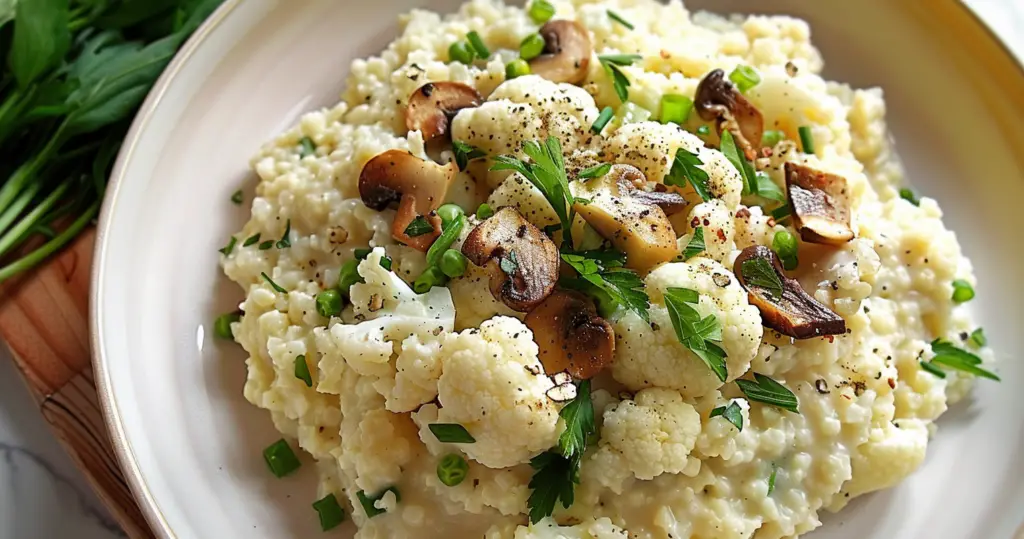Cauliflower risotto is a delicious and nutritious alternative to traditional risotto. By using cauliflower instead of rice, this dish offers a lower-carb, keto-friendly option without sacrificing flavor or texture. Whether you’re following a specific diet or just looking for a new way to enjoy cauliflower, this guide will provide you with all the information you need to create the perfect cauliflower risotto.

Overview of Cauliflower Risotto
Cauliflower risotto replaces the starchy rice with finely chopped or riced cauliflower, creating a dish that’s both light and satisfying. This alternative is not only lower in carbs but also quicker to prepare. Traditional risotto requires constant stirring and gradual addition of broth. Cauliflower risotto, however, cooks in a fraction of the time while still delivering a creamy, rich texture.
Cauliflower risotto can be made with a variety of ingredients, allowing you to customize it to your taste preferences. Popular additions include mushrooms, garlic, onions, and Parmesan cheese. The versatility of this dish makes it a great choice for weeknight dinners, special occasions, or meal prep.
Historical Background and Cultural Significance
Risotto is a classic Italian dish that dates back to the 14th century. It originated in Northern Italy, where rice paddies are abundant. Traditional risotto is known for its creamy texture and the meticulous process of cooking rice slowly while adding broth.
The adaptation of cauliflower into risotto is a more recent innovation, driven by the growing popularity of low-carb and gluten-free diets. As more people seek healthier alternatives to traditional high-carb dishes, cauliflower has become a versatile substitute in many recipes, including pizza crusts, mashed potatoes, and rice dishes.
For more information on traditional risotto and its origins, visit the Risotto Wikipedia page.
Popularity and Variations
Cauliflower risotto has gained popularity for its health benefits and versatility. It’s particularly favored by those on low-carb, keto, and gluten-free diets. The dish can be easily modified to fit different dietary needs, such as vegan or dairy-free versions.
Variations of Cauliflower Risotto:
- Mushroom Cauliflower Risotto: Adds earthy flavors with mushrooms.
- Cheesy Cauliflower Risotto: Uses different cheeses for a richer taste.
- Garlic and Herb Cauliflower Risotto: Infused with fresh herbs and garlic for a robust flavor.
- Vegan Cauliflower Risotto: Made with plant-based ingredients.
For more creative risotto ideas and inspiration, check out these Healthy Dinner Ideas on Pinterest.
Benefits of Making Cauliflower Risotto
Making cauliflower risotto at home has several benefits. You can control the quality and freshness of the ingredients, ensuring a healthier and more flavorful dish. Homemade cauliflower risotto is free from preservatives and artificial flavors often found in store-bought versions. Additionally, preparing the risotto at home allows you to customize the recipe to suit your taste preferences and dietary needs.
The process of making cauliflower risotto is also quicker and more straightforward compared to traditional risotto. Since cauliflower cooks faster than rice, you can have a delicious and nutritious meal on the table in less time. This makes it an excellent choice for busy weeknights or when you need a quick, healthy dinner option.
For a comprehensive list of ingredient substitutions and nutritional benefits, visit the Cauliflower Wikipedia page.
By exploring the history, variations, and benefits of cauliflower risotto, you are well on your way to mastering this versatile dish. Stay tuned for the next sections, where we’ll dive into the preparation phase, essential tools, and detailed instructions to ensure your cauliflower risotto turns out perfectly every time. For more on the nutritional benefits of cauliflower and other ingredients, check out our Nutritional Guide.
Preparation Phase & Tools to Use
Essential Tools and Equipment
Before diving into making cauliflower risotto, it is crucial to gather all the necessary tools and equipment. Proper preparation ensures a smooth cooking process and the best results.
- Sauté Pan: A large sauté pan or skillet with a heavy bottom is essential for cooking the cauliflower and other ingredients evenly.
- Food Processor: To rice the cauliflower efficiently, a food processor is highly recommended. It helps achieve the perfect texture quickly.
- Measuring Cups and Spoons: Accurate measurements are crucial for consistency in recipes.
- Spatula and Wooden Spoon: For stirring and mixing ingredients.
- Cutting Board and Knife: For chopping vegetables and other ingredients.
- Grater: If you’re using fresh Parmesan cheese, a grater will be needed.
- Mixing Bowls: Various sizes for combining and preparing ingredients.
For more detailed information on essential kitchen tools, visit the Baking Tools Wikipedia page.
Importance of Each Tool
Each tool plays a vital role in the preparation of cauliflower risotto. The sauté pan ensures even cooking and prevents sticking. The food processor makes ricing cauliflower quick and easy, while measuring cups and spoons ensure you use the correct amount of each ingredient. A spatula or wooden spoon is necessary for stirring without damaging your cookware. Using a cutting board and knife keeps your prep area clean and organized, and a grater allows for freshly grated Parmesan, which enhances the flavor.
Preparation Tips
Proper preparation is key to a smooth cooking process. Here are some tips to ensure everything goes perfectly:
- Read the Recipe: Review the entire recipe before starting. This helps you understand the steps and gather all ingredients and tools.
- Mise en Place: Prepare all your ingredients beforehand. Measure and place them in separate bowls to streamline the process.
- Wash and Dry Vegetables: Ensure all vegetables are clean and dry before use. This prevents excess moisture in the risotto.
- Rice the Cauliflower: If you don’t have pre-riced cauliflower, use a food processor to pulse cauliflower florets until they resemble rice grains. Do this in batches to avoid overcrowding the processor.
For tips on preparing cauliflower rice, check out The Toasty Kitchen’s guide.
Ingredients List
To make a delicious cauliflower risotto, you’ll need the following ingredients:
Basic Ingredients
- 1 small head of cauliflower, cut into florets
- 1 tablespoon olive oil
- 1 small onion, finely chopped
- 2 cloves garlic, minced
- 1 cup sliced mushrooms (optional)
- 1/2 cup vegetable or chicken broth
- 1/2 cup heavy cream or coconut milk (for a dairy-free option)
- 1/4 cup grated Parmesan cheese
- Salt and pepper to taste
- Fresh parsley or thyme (for garnish)
Ingredient Variations
You can adjust the ingredients to accommodate dietary preferences and add unique flavors:
- Vegan: Use vegetable broth and coconut milk instead of heavy cream. Omit the Parmesan cheese or use a vegan alternative.
- Keto-Friendly: Ensure all ingredients are low-carb and use high-fat cream or cheese.
- Flavor Enhancements: Add herbs like thyme or rosemary for extra flavor. Try different cheeses like Gruyère or cheddar for a twist.
For a comprehensive list of ingredient substitutions and nutritional benefits, visit the Cauliflower Wikipedia page.
Related Recipes and Inspirations
Explore other cauliflower-based recipes to expand your culinary repertoire:
By gathering the right tools and preparing your ingredients, you’ll set yourself up for success in making the perfect cauliflower risotto. Stay tuned for the next section, where we’ll provide step-by-step instructions to guide you through the entire process. For more tips on preparing your kitchen, don’t miss our Kitchen Preparation Guide. If you’re curious about different risotto variations, explore our Risotto Variations Guide.


Leave a Comment